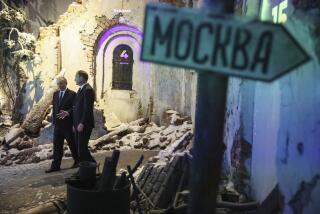Soviets Seen Reassessing Nuclear Safety
- Share via
WASHINGTON — In the wake of the Chernobyl disaster, Soviet nuclear experts appear to be going through a reassessment similar to that which followed the United States’ 1979 accident at Three Mile Island, the head of a nuclear safety delegation just back from the Soviet Union said Friday.
Among steps under way are new accident probability studies, the centralization of safety responsibilities and plans to retrofit reactors similar to the stricken unit at Chernobyl with higher-speed control rods for emergency shutdown, Fred M. Bernthal of the Nuclear Regulatory Commission told reporters.
“They are going through much the same thing in their country that we went through after Three Mile Island,” he said. “We were chastened by TMI. . . . It’s quite clear their safety effort is being more centralized and strengthened.”
Visited Chernobyl
Bernthal and nine other U.S. nuclear safety officials spent two weeks in the Soviet Union earlier this month, talking with their Soviet counterparts and paying the first visit by U.S. experts to Soviet nuclear facilities in 10 years.
The climax to the mission came when three members of the U.S. delegation visited the site of the Soviet nuclear disaster in the Ukraine last April.
Although communities within an 18-mile radius of the reactor remain evacuated, Bernthal said, two adjacent nuclear units are now back in operation at full power. A third unit contaminated by the accident, but not otherwise involved in it, will be restarted later this year, Soviet officials told the visiting Americans.
The Soviets, Bernthal said, appear to have completed the process of sealing the damaged reactor within a cement “sarcophagus,” with provisions made for continuous monitoring of conditions within the plant in case a chain reaction should resume.
Toured Power Plants
At the time of the Americans’ visit, the concrete structure enclosing the damaged reactor was covered by snow, indicating that the intense heat had dissipated.
Besides visiting the site of the world’s worst nuclear accident, the delegation also toured the Soviet Union’s newest power plants in the southeastern Ukraine, and Bernthal said that they found Soviet safety precautions “consistent with that followed in much of the rest of the world now.”
Although he concluded that the Soviets have undertaken a serious reassessment of their nuclear power program since the accident, Bernthal said there is nothing to indicate second thoughts on the government’s commitment to nuclear power to meet its 10%-a-year growth in electrical power demand.
The Soviet Union now has about one-third of the nuclear generating capacity of the United States and has only in recent times begun building reactors on the 1,000-megawatt scale common in the West.
One bonus of the tour was the American delegation’s opportunity, during a visit to a facility where Soviet reactor components are fabricated, to see a pressure vessel being made for a 440-megawatt pressurized water reactor being built in Cuba.
“They were very open in discussing all the questions we asked,” Bernthal said. “In fact, I think we exhausted ourselves and them after 3 1/2 hours.”
More to Read
Sign up for Essential California
The most important California stories and recommendations in your inbox every morning.
You may occasionally receive promotional content from the Los Angeles Times.













